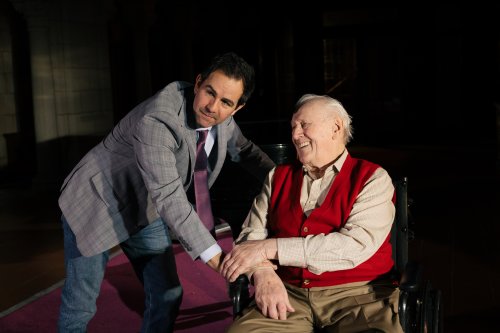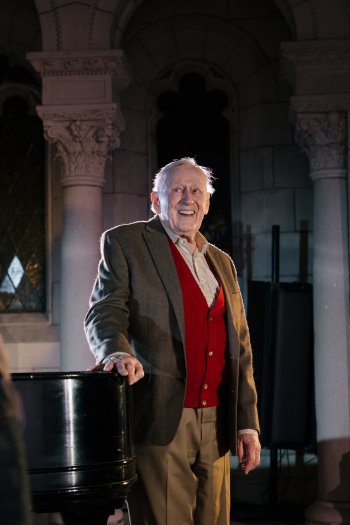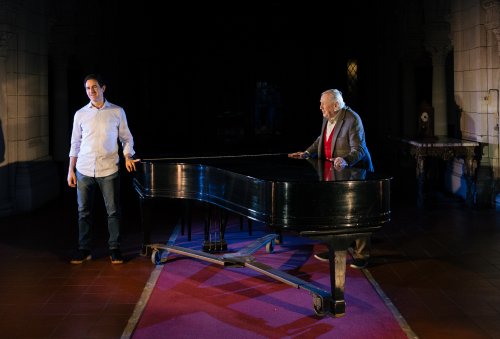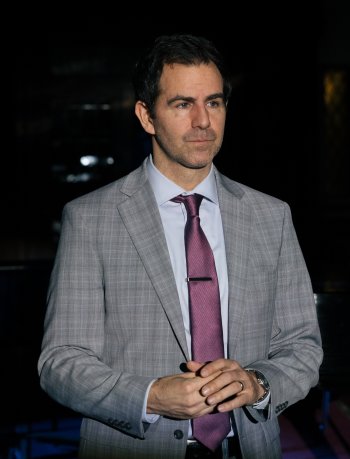Tuesdays with Morrie
A beautifully orchestrated production with Len Cariou and Christopher J. Domig.

Christopher J. Domig as Mitch Albom and Len Cariou and Morrie Schwartz in a scene from the Sea Dog Theater production of “Tuesdays with Morrie” at St. George’s Episcopal Church (Photo credit: Jeremy Varner)
[avatar user=”Scotty Bennett” size=”96″ align=”left”] Scotty Bennett, Critic[/avatar]
Dylan Thomas urged all who would listen to:
“Do not go gentle into that good night,
Old age should burn and rave at the close of day;
Rage, rage against the dying of the light.”
Rage is violent, explosive anger, so Thomas is telling his readers to be angry about death, to fight and scream against the fates that are bringing one’s life to an end. Consider, if you will, another way of approaching the end that all mortal beings will reach: one of gentle acceptance, reflection, and understanding. Such is the way of the late Morrie Schwartz, as told by Mitch Albom in his memoir of his beloved professor and friend.
Tuesdays with Morrie by Jeffrey Hatcher and Mitch Albom is a perfect adaptation of Albom’s book of the same name, which has sold 20 million copies since 1997. It was initially adapted for film in 1999 and then for the stage in 2002, where it was produced Off-Broadway at the Minetta Lane Theatre. The stage version has been produced continuously worldwide since that first stage production.
Seadog Theater’s current revival of Tuesdays with Morrie, with exceptional direction by Erwin Maas, is a beautifully orchestrated presentation starring Len Cariou as Professor Morrie Schwartz and Christopher J. Domig as author Mitch Albom. The chemistry between these actors is riveting, grabbing one’s attention solidly but gently from the opening moments to the tearful end. They are a perfect match to tell this story. Don’t hesitate, for a moment, to see this production. You will laugh, cry, and come away feeling that you just experienced something extraordinary.
As the audience enters the theater, Domig plays a mellow jazz riff on a piano. This does not seem necessarily connected to the play but registers as an introduction to the theater space. Cariou enters and sits near the piano while members of the audience are still filing in. When the lights dim, a spot shines on Domig, and he begins his opening monologue directed to the audience.

Len Cariou as Morrie Schwartz in a scene from the Sea Dog Theater production of “Tuesdays with Morrie” at St. George’s Episcopal Church (Photo credit: Jeremy Varner)
Mitch is looking back in time as he tells us of his meeting and subsequent interactions with Morrie while Mitch was a student at Brandeis University and Morrie Schwartz was a professor of Sociology. This opening could almost be considered an extended prologue for what is to follow. It is beautifully done as Domig and Cariou alternately speak to each other about that time and to the audience, clarifying some of the details and providing insights into the characters of the two men. Watching Cariou and Domig interact is almost as if Morrie and Mitch were standing before us.
The connection between the two was strong enough that Morrie became Mitch’s mentor. He took all of Morrie’s classes and spent Tuesdays with him in his office. He called him Coach, and as the play makes clear, it was an apt description, not only for Mitch but also for the many people who have read the things Coach and Mitch spoke about at the end of Morrie’s life.
One of the early encounters finds Morrie discovering Mitch in the basement of the Music Department playing the piano. When Mitch finally hears Morrie banging on the music room door, he lets him in. Morrie tells Mitch that he is good and should pursue his music. Given his parents’ desires, we learn that this is not an option. In this conversation, we discover that Mitch learned to play the piano from his uncle, an important piece of information for later in the play.
On Mitch’s graduation day, Morrie made Mitch promise to stay in touch. Mitch pledged to but didn’t keep his promise. It would be 16 years before the two would meet again. By this time, Mitch had become a very successful sports reporter and writer with a newspaper column, radio and television shows, and published books. He was at the top of his game when he learned about Morrie’s fatal illness from, of all places, an interview by Ted Koppel on Nightline.
Mitch calls Morrie to say hello and wish him well and nothing more, but that is not what happens. He makes a visit to Morrie, and it happens to fall on a Tuesday; that first visit ultimately turns into more, all on Tuesdays, and from that first Tuesday until Morrie’s death, we learn the lessons about death and dying that Coach Morrie has to offer.

Christopher J. Domig as Mitch and Len Cariou as Morrie in a scene from the Sea Dog Theater production of “Tuesdays with Morrie” at St. George’s Episcopal Church (Photo credit: Jeremy Varner)
After the Nightline interview, Morrie begins to receive letters from all over the country. He tries to respond to all of them, and Mitch helps when he is with Morrie. In one exchange, Mitch asks Morrie why he makes the effort to respond.
MORRIE. I just want to make them feel better.
MITCH. You want to make them feel better – Morrie, if anyone FINALLY earned the right to say “Let’s not talk about your problems, let’s talk about me” …I mean, you’ve hit the mother lode of sympathy. Take advantage!
MORRIE. Mitch, why would I take like that? Taking makes me feel like I’m dying. Giving makes me feel like I’m living. Will you write that down?
And a moment that shows what led Morrie to find understanding and acceptance that with ALS, he did not have long to live.
MITCH. So. How can one be prepared to die?
MORRIE. Do what the Buddhists do. Every day, have a little bird on your shoulder that asks, “Is today the day?” Am I ready? Am I being the person I want to be?
MITCH. You’re into Buddhism now? I thought you were an Agnostic.
MORRIE. I used to be Agnostic; now I’m not so sure. The truth is: Once you learn how to die, you learn how to live. I wish I’d been aware of death every day of my life.
There are many wonderful moments in this production, too many to mention in this review. You must go and experience all the feelings and understanding that come from it.

Christopher J. Domig as Mitch in a scene from the Sea Dog Theater production of “Tuesdays with Morrie” at St. George’s Episcopal Church (Photo credit: Jeremy Varner)
The nature of the venue, a large high-ceiling church hall, leads to some interesting adjustments for staging. The set consists of a piano, a couple of chairs, a walker, and a wheelchair that doubles as a recliner. The sparseness of the setting is of little consequence; there is nothing to distract from the words and actions of the performers, and when combined with the lighting, it all works in support of the story. Guy De Lancey is the designer of the sets, lighting, and costumes.
There is an issue with echo in the hall since there are no sound-absorbing fixtures, but, like adjusting to accents in a play, the action, plus exceptional sound design, makes the echo less noticeable as the show unfolds. Eamon Goodman’s sound design perfectly defined the various moments in the show when voiceovers, music, and background sounds are called for.
Two other sound-related things need to be mentioned. Domig wrote and performs original piano music that is integral to the story of Mitch Albom’s relationship with Morrie Schwartz. There is also a moment in the show when Mitch’s wife Janine, is with him on one of the visits, and she sings for Morrie. We never see Janine, but we do hear Sally Shaw’s wonderful singing.
Tuesdays with Morrie (March 1 – 23, 2024; return engagement: April 1 – 20, 2023)
Sea Dog Theater
St. George’s Episcopal Church, 209 East 16th Street in Manhattan
For tickets, visit https://www.tickettailor.com/events/seadogtheater
Running time: one hour and 40 minutes without an intermission






Leave a comment